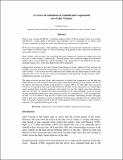| dc.contributor.author | Okonga, Joel Richard | |
| dc.date.accessioned | 2015-11-10T07:21:00Z | |
| dc.date.available | 2015-11-10T07:21:00Z | |
| dc.date.issued | 2002 | |
| dc.identifier.citation | A review of estimation of rainfall and evaporation over Lake Victoria Joel Richard Okonga Directorate of Water Development, Water Resources Management Department, P.O. Box 19, Entebbe, Uganda | en_US |
| dc.identifier.uri | http://hdl.handle.net/11671/724 | |
| dc.description.abstract | With its area covering 68,800 km2, a shoreline length of about 3,450 km around a basin area of about
258,700 km2, a mean depth of 40 meters and sometimes up to a maximum of 84 meters, Lake
Victoria’s hydrology has been one of the most difficult and controversial to understand.
Of the most interesting aspect of the hydrology is the sudden rise that the lake underwent in a matter of
a few months in 1961 by almost 2.5 meters following a long period of near constant levels about the
mean earlier in the last century.
Many scholars and researchers and consulting firms have attempted to explain this sudden jump with
very few of them towing a common line. Several theories were advanced ranging from increased
rainfall, effect of Owen Falls dam, and the invalidity of the "Agreed Curve" developed from the stagedischarge
ratings curves of the then Rippon falls before inundation.
Following the inception of the Lake Victoria Water Resources Project funded by FAO and now the
LVEMP, increased automated instrumentation was installed in the islands and around the shores of
Lake Victoria. A lot of data has been collected in the islands and this paper intends to throw light,
using this data, to two of the most controversial elements of the hydrology of Lake Victoria. That is
rainfall and evaporation over the lake The paper reviewed previous efforts and estimations of rainfall and evaporation over the lake and
tackled the present state using measured rather than estimated data like the previous authors. Results of
the analysis show that for example in the period of 1st August 1998 to 31st May 2001, there was more
water loss to evaporation than a gain from rainfall over the lake. In the same period, too, rainfall input
nearly equaled inflow from the catchments with rainfall over the lake slightly more than catchment
input into the lake. In summary the relative percentages of the main hydrologic processes of Lake
Victoria in millimeter depth in the above period are: 43.8% of evaporation loss; 31.9% of rainfall over
the lake; 14.2% of outflow at Jinja and 10.1% inflow from catchments surrounding the lake. The paper
looks at time series variations in order of importance of the processes and the results are shown in the
body of the paper. Further research on the rest of the elements of the water balance of Lake Victoria is
expected to be stimulated following this work | en_US |
| dc.language.iso | en | en_US |
| dc.publisher | Directorate of Water Development, Water Resources Management Department, P.O. Box 19, Entebbe, Uganda | en_US |
| dc.subject | Agreed curve | en_US |
| dc.subject | Water balance | en_US |
| dc.subject | Rainfall | en_US |
| dc.subject | Evaporation | en_US |
| dc.subject | Lake Victoria | en_US |
| dc.title | A review of estimation of rainfall and evaporation over Lake Victoria | en_US |
| dc.type | Article | en_US |

